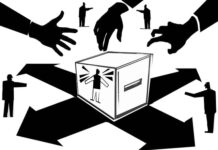If denying people access to fresh water, food, health services, and proper education all violate human rights, why then is…
If denying people access to fresh water, food, health services, and proper education all violate human rights, why then is climate change not seen as the world’s largest human rights violations?
In early July this year, the United Nations Human Rights Council adopted a resolution that firmly makes the connection between human rights and climate change.
The resolution, adopted through consensus, includes eleven paragraphs linking human rights to the international climate talks, known as the United Nations Framework Convention on Climate Change (UNFCCC).
Bangladesh, along with the Philippines and Vietnam, was one of the key countries spearheading the resolution at the Council. Ms. Nahida Sobhan, a Bangladesh diplomat, eloquently stated:
“Compared to any time in the past, accomplishing a world of dignity, a world of peace, a world of fairness, a world of justice may remain a far cry if we fail to factor in innovative ways to provisioning human rights of the climate-affected people.”
It is essential that we do not only address climate change as a technical and scientific issue, but as a human rights one as well.
Climate change a human rights issue
Typically for human rights to be violated a traceable entity needs to violate another person’s rights, the blame must be obvious.
Mother Nature can’t violate human rights as a volcanic eruption, mudslide, or meteor blast are all outside human control even though they put individuals in harm’s way.
But if a country is causing the conditions for human rights to be abused in another country, it becomes an international issue. Climate change does not deliberately violate people’s human rights, but it can create an environment where rights are violated.
More research is needed on how to lessen the negative environmental impacts of seaborne trade. Yet overall Bangladesh is in a good position not only for green growth but for protecting and utilising our oceans as well
Climate change threatens people’s access to food, shelter, and education.
It threatens progress made on the right to development, reducing gender inequality and other forms of discrimination. In the case of small island states, it threatens sovereignty and statehood.
Ultimately, climate change is a threat to our most basic rights — the right to life and the right to health.
International climate talks
Many remain skeptical of bringing human rights into the climate talks. Forgetting the fact a separate UN body already exists for human rights, there is concern that integrating rights into the UNFCCC will further confuse a complicated process. By making climate change a technical, scientific issue, it is also a lot easier to make deals to push countries to act on climate change because the notion of culpability lessens.
On the other hand, addressing human rights may change the nature of the negotiations for the better.
For instance, one reason the United States did not ratify the Kyoto Protocol in 1997, intended to reduce global greenhouse emissions, was because countries with increasing greenhouse gas emissions such as India and China were not required to participate in the Protocol.
Under a human rights framework, whether or not India and China took climate action would not matter: The United States would be required to reduce emissions because of its own obligation to human rights.
This is what is meant by human rights providing a “common standard” to the UNFCCC. While countries may have different positions at the negotiations, they will still have to adhere to universal human rights obligations under International Human Rights Law.
Is loss and damage a human rights issue?
Loss and damage may be one of the more obvious links between these two issues. Loss and damage is a technical term referring to the devastating impacts of climate change that people are unable to adapt to. This includes loss of land, culture, and even lives — all rights which countries are obliged to protect.
Yet when you examine the Loss and Damage mechanism in the UNFCCC, named the Warsaw International Mechanism, there is no mention of human rights at all.
A reason may be that when we start talking about human rights violations, we need to talk about who is responsible. As mentioned before, human rights cannot just be violated: Some entity needs to have caused the violation. Once developed countries take responsibility for climate change as a human rights violation, the issue of compensation and liability invariably arises.
Developed countries are extremely hesitant to directly compensate those most adversely affected by climate change. Compensation was not only explicitly left out of the Loss and Damage article in the recently ratified Paris Agreement, but during negotiations various developed countries wanted to ensure compensation would never be a part of future talks.
Perhaps human rights can help the plight of Loss and Damage in another way. Countries are obligated to act in solidarity to protect human rights around the world. So if Loss and Damage violates human rights, countries under international human rights law are required to help out.
Bringing climate change to court
One of the most recent high profile cases on climate change linked to human rights comes from the Netherlands — the Urgenda Case. Leading climate change and human rights lawyers appealed that the government was not doing enough to reduce its greenhouse gas emissions, arguing it was a human rights concern worldwide. The Dutch government is now required to reduce its emissions by a minimum of 25% by 2020 compared to 1990.
If action on preventing climate change can be grounded in human rights, it only makes sense that the consequences of not acting would be a violation.
The Urgenda case gives hope for future cases to be fought elsewhere linking human rights to climate change. Even if litigation is unsuccessful, these cases bring considerable media attention to the relationship between these two issues.
A human rights lens
Many were excited to see two references to human rights in the preamble of the recent Paris Agreement. The preambles colours how the operational part of the text should be read.
“There is no longer any room for arguing that human rights do not fall squarely within the climate discussion,” said Ben Schachter from the Office of the High Commissioner for Human Rights.
Even if we cannot incorporate human rights officially into the UN climate talks, we view the Paris Agreement through a human rights lens.
Tools like human rights indicators and human rights assessments may be very useful for future planning.
Lots of countries party to the UNFCCC have ratified the UN conventions on human rights. It only makes sense these countries seriously consider human rights when taking climate action.
Mickael De Souza studies Anthropology and Sociology at Concordia University; Laura Pasternak is doing her Master’s in Human Rights Law at the University of Strathclyde; and Meraz Mostafa works at the International Center of Climate Change and Development and manages this DT-ICCCAD page.
Source: Dhaka Tribune










